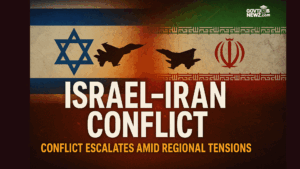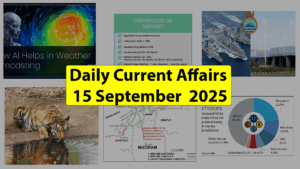Daily Current Affairs- 20th September 2025 | Latest News
Daily Current Affairs- 20th September 2025 | Latest News
Machu Picchu
Recently, many tourists were stranded near Peru’s ancient Inca citadel of Machu Picchu after a passenger train service was suspended due to a protest.
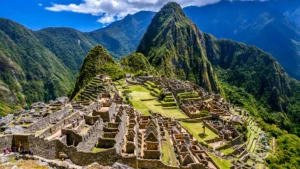
About Machu Picchu –
- It is a 15th-century Inca civilisation site of
- Location: It is located 80 km northwest of Cuzco, Peru, in the Cordillera de Vilcabamba of the Andes Mountains.
- It is saddled between two peaks-Machu Picchu (“Old Peak”) and Huayna Picchu (“New Peak”)
—at an elevation of 7,710 feet.
- It is believed to have been built by Pachacuti Inca Yupanqui, the ninth ruler of the Inca, in the mid-1400s.
- Monuments: This citadel is made up of temples, palaces, terraces, monuments, complexes and walls; in addition to water channels, built with large blocks of stone, without any amalgam, proof of the great wisdom of the Inca civilisation.
- Machu Picchu was rediscovered in 1911 by the American explorer Hiram
- It was designated a UNESCO World Heritage site in
Key facts about Inca Civilisation –
- Time Line: It flourished in ancient Peru between 1400 and 1533 CE.
- It is the largest empire ever seen in the Americas and the largest in the world at that
- Society: Inca society was highly stratified. The emperor ruled with the aid of an aristocratic
- Architecture and Technology: Inca technology and architecture were highly
- Religious belief: The Inca religion combined features of animism, fetishism, and the worship of nature gods.
Saudi-Pakistan Defence Ties
Pakistan and Saudi Arabia have signed a landmark mutual defence pact, formalising a security partnership rooted since the 1960s.
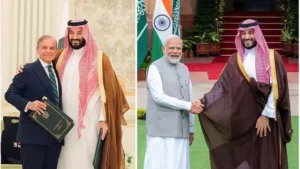
The agreement declares that “any aggression against either country shall be considered aggression against both.” It aims to deepen defence cooperation and strengthen joint deterrence in the region.
The pact, finalised after Israel’s recent strike in Qatar and amid waning US defence assurances, marks the first major defence agreement between an Arab nation and a nuclear-armed state.
While Saudi Arabia maintains close ties with India as well, this development signals a significant strategic shift in regional security dynamics.
Saudi Arabia-Pakistan Defence Pact and India’s Response –
- During Prime Minister Shehbaz Sharif’s visit to Riyadh, Pakistan and Saudi Arabia signed a mutual defence pact declaring that “any aggression against either country shall be considered an aggression against both.”
- The agreement builds on nearly eight decades of partnership, rooted in brotherhood, Islamic solidarity, and strategic defence cooperation.
- It aims to strengthen deterrence and promote regional and global
- The defence pact signals a strategic shift, particularly as Saudi Arabia balances its close ties with both Pakistan and India.
- It highlights the evolving security and diplomatic landscape in the
• India’s Cautious Response to Saudi-Pakistan Defence Pact —
- India reacted carefully to the Saudi Arabia-Pakistan mutual defence agreement, with MEA spokesperson noting that the government was aware of the long-standing arrangement.
- The Ministry of External Affairs said it will study its implications for national security and regional stability, reaffirming India’s commitment to protecting its
Deepening Pakistan-Saudi Arabia Defence Ties –
- Pakistan and Saudi Arabia share a long history of military cooperation, beginning with Pakistani troop deployments in the 1960s and special forces support during the 1979 Mecca Grand Mosque crisis.
- Their ties were institutionalised in 1982 through a Bilateral Security Cooperation Agreement, enabling training, advisory roles, and arms sales.
- Pakistani personnel have played a key role in training the Saudi Air Force, while Saudi Arabia has been a major arms buyer.
- Recent meetings have pledged expanded training and
- The latest defence pact marks Pakistan’s most significant formal commitment in decades, securing Saudi investment during its fiscal crisis and reinforcing its pan-Islamic security role.
- Analysts suggest Pakistan may now access S. weapons through Saudi funding.
- For Riyadh, the pact strengthens defences against Iran, Houthi militias, and instability triggered by Israel’s actions.
Saudi Arabia’s Strategic Ties with India –
• Economic Partnership —
• Saudi Arabia is India’s fifth-largest trading partner, while India is its second-largest.
- In FY 2023-24, bilateral trade reached USD 42.98 billion, with Indian exports at USD 11.56 billion and imports at USD 31.42 billion.
• Political and Strategic Milestones —
- Relations deepened with King Abdullah’s 2006 visit, leading to the Delhi Declaration, followed by the Riyadh Declaration in 2010 that elevated ties to a Strategic
- In 2016, PM Narendra Modi’s visit saw him receive Saudi Arabia’s highest civilian honour, the ‘King Abdulaziz Sash’.
• Recent Engagements and Crisis Diplomacy —
- High-level exchanges have since continued. During PM Modi’s April 2025 visit, Saudi Arabia swiftly condemned the Pahalgam terror attack.
- Its Minister of State for Foreign Affairs also visited during Operation
• Balanced Approach on Sensitive Issues —
- Saudi Arabia has maintained measured positions during India-Pakistan tensions — condemning terror attacks like Pulwama, but refraining from criticising India’s Article 370 abrogation or the Balakot strikes.
- It has often positioned itself as a mediator, engaging with both
Gag Order in Adani Case
Recently, a lower court issued a sweeping ex-parte gag order restraining several journalists, including Paranjoy Guha Thakurta, from publishing allegedly defamatory content against Adani Enterprises Limited (AEL). The order also directed removal of numerous articles and social media posts.
Following this, the Ministry of Information and Broadcasting issued takedown notices, resulting in the removal of 138 YouTube videos and 83 Instagram posts — some being satire or indirect references to Adani.
SC Guidelines on Defamation Injunctions –
• The Bonnard Standard —
- The Supreme Court follows the Bonnard principle (1891, Bonnard vs Perryman).
- It states that a court can grant an injunction only when it is satisfied that the defendant may not be able to justify the defamation, and not merely when it suspects
• SC’s Bloomberg Ruling (2024) —
- In 2024, the SC applied this principle while overturning an ex parte injunction ordering Bloomberg to take down an article on Zee Entertainment.
- The Court stressed that pre-trial injunctions should be rare, granted only when withholding them would cause “greater injustice.”
• Supreme Court’s Caution on Ex Parte Orders —
- The SC has held that ex parte injunctions in free speech cases must only be granted in exceptional circumstances, and only when content is “malicious” or “palpably ”
- Otherwise,they risk stifling public debate and undermining the public’s right to know.
The September 6 Adani Gag Order –
- A Delhi court issued a blanket gag order restraining Paranjoy Guha Thakurta and others from publishing content about Adani Enterprises Limited (AEL), while also authorising takedown of existing material within 36 hours.
- This judgement had serious lacunas —
- No judicial examination of the allegedly defamatory content was carried
- The order effectively allowed AEL to curate public information about
- Journalists were restrained from publishing “unverified or defamatory” reports, amounting to
prior restraint — unconstitutional under Article 19(1)(a).
• Why Prior Restraint is Problematic?
- Restrictions on speech are valid only under Article 19(2), covering grounds like sovereignty, security, public order, morality, and
- But prior restraint carries a heavy burden of proof and is rarely
- Journalists must be heard since truth and fair comment are lawful defences in defamation
Delhi Court Quashes Gag Order in Adani Defamation Case –
- Later, District Judge of Delhi Court quashed the gag order for four journalists — Ravi Nair, Abir Dasgupta, Ayaskant Das, and Ayush Joshi — stating the order was
- The court emphasised that the journalists had not been given an opportunity to be heard, violating principles of natural
- It noted that declaring articles defamatory and ordering their removal without defence could lead to irreversible consequences.
- If later found non-defamatory, restoring removed content would be
• Key Highlights of the Judgement —
- The gag order was quashed for being ex-parte and unsustainable.
- An ex parte order is a court ruling made at the request of one party without the other being present or notified.
- It is granted only in urgent situations for temporary relief, such as restraining orders, to prevent harm until a full hearing with both parties ensures fairness and due process.
- The court reaffirmed that defendants must be given a chance to present their defence before sweeping takedown orders.
- Judge warned against irreversible harm from premature content
- The ruling narrowed the scope but left other related appeals and the main defamation trial pending.
Onion Sector in India
Maharashtra’s onion farmers are protesting after prices crashed below production costs, demanding compensation, stable export policies, and procurement support.
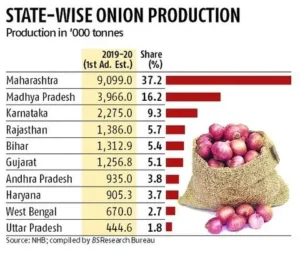
Onion Production in India –
- India is the world’s second-largest producer of onions, after China, with annual production averaging 25–30 million tonnes.
- Maharashtra, Madhya Pradesh, Karnataka, Gujarat, and Rajasthan are the leading
- The country grows three onion crops, Kharif, Late Kharif, and Rabi, with Rabi onions having higher storage potential and accounting for nearly 60% of annual output.
- Maharashtra dominates production due to a favourable climate and large-scale cultivation in districts like Nashik, Ahmednagar, Pune, and However, despite its massive output, the sector faces persistent problems.
Challenges Faced by the Onion Sector –
- Price volatility — Onions often witness extreme price fluctuations due to excess production, poor storage, and sudden export restrictions.
- Storage losses — A significant portion of Rabi onions deteriorates due to poor storage infrastructure, leading to wastage and distress sales.
- Export policy flip-flops — Frequent bans and restrictions undermine India’s credibility in global onion markets, leading to competitors like China and Pakistan capturing India’s lost share.
- High production costs — Fertilisers, seeds, storage, and labour raise production costs to Rs. 2,200–Rs. 2,500 per quintal, but farmers often receive far less in the
News Summary –
- Farmers in Maharashtra began agitating on September 12, 2025, after onion prices fell
- Currently, they are receiving only 800-Rs. 1,000 per quintal, less than half the cost of production.
- The crisis worsened because Rabi onions stored in anticipation of higher prices began deteriorating, forcing distress sales.
- Adding to the distress, the government released buffer stocks into the market through the National Cooperative Consumers’ Federation (NCCF) and National Agricultural Cooperative Marketing Federation of India (NAFED).
- While the buffer stock policy aims to stabilise consumer prices, it further dragged down wholesale rates, aggravating farmers’ losses.
• Farmers’ Demands —
- A compensation of 1,500 per quintal for the losses.
- Immediate halt to the sale of NCCF and NAFED buffer stocks in
- A uniform and stable export policy to restore trust among importing
- Discussions with key buyers like Bangladesh and Sri Lanka, which were once major markets for Indian onions.
• Impact of Export Policy —
- India exported 25.25 lakh tonnes of onions in 2022–23, but exports fell drastically to 11.47 lakh tonnes in 2024–25.
- This sharp fall eroded India’s competitiveness, with buyers shifting to China and
- Experts argue that inconsistent export policies have damaged India’s reputation in global
• Alternative Solutions Suggested —
- Farmers and exporters have urged the government to incentivise exports to regain India’s lost market share.
- Replicating Andhra Pradesh’s procurement model, where onions are purchased at 1,200 per quintal, is being suggested for Maharashtra to ensure a minimum support price.
- Long-term measures such as cold storage expansion and farmer-producer organisations (FPOs) for collective bargaining have been emphasised.
Conclusion –
- The onion crisis in Maharashtra reflects the deep-rooted systemic flaws in India’s agricultural pricing and export policies.
- While buffer stock release and price stabilisation policies aim to protect consumers, they often end up hurting farmers.
- The current protests underline the urgent need for structural reforms, from stable export strategies to better procurement models and infrastructure upgrades.
- Without these, India’s onion farmers will remain at the mercy of volatile markets, recurring protests, and policy inconsistencies.
NE-SPARKS Programme
Recently, the Union Minister of Development of North Eastern Region and Communications virtually interacted with school students from the North Eastern states who visited ISRO under NE-SPARKS program.
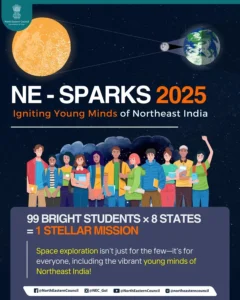
About NE-SPARKS Programme –
- The ‘North East Students’ Programme for Awareness, Reach, and Knowledge on Space’ (NE-SPARKS), is a flagship initiative supported by the Ministry of Development of North- East Region (MDoNER ) in collaboration with 8 North Eastern States.
- It is a pioneering initiative aimed at igniting curiosity and fostering awareness about space science and technology among students from the North Eastern Region (NER) of India.
- This programme exposes Northeastern students to ISRO’s cutting-edge space technology, with the goal of sparking interest in Science, Technology, Engineering, and Mathematics (STEM)
- It seeks to bridge geographical and informational gaps by providing students with an immersive experience of India’s advancements in space research and exploration through visits to ISRO Centre in Bengaluru.
- The programme envisages exposure visits for 800 meritorious science students (100 from each state of NER) to premier ISRO Centres at Bengaluru.
- Funding: The program is funded by the MDoNER and the state in 60:40 ratio.
FAO’s Technical Cooperation Programme
Recently, the Ministry of Fisheries, Animal Husbandry and Dairying has signed a Technical Cooperation Programme (TCP) agreement with the Food and Agriculture Organisation (FAO) to strengthen Blue Port infrastructure in India.
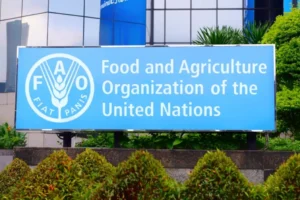
About FAO’s Technical Cooperation Programme –
- It was created to enable FAO to make its know-how and technical expertise available to member countries upon request.
- Purpose: To help countries improve their population’s food security and alleviate poverty with lasting impact.
- Goal: To assist in solving technical problems in crop production, livestock, fisheries and aquaculture, forestry, nutrition, food safety, rural development and other areas identified in the Country Programming Framework (CPF).
- Funding: The Technical Cooperation Programme is part of FAO’s Regular Programme budget. This means that TCP funds come directly from the dues paid by FAO members.
- The FAO’s TCP programme on ‘Strengthening of Blue Ports’ intends:
- To assist the GoI to strengthen the fishing ports’ technical capacities to address the main environmental, social and economic challenges that affect the aquatic value
- Two pilot fishing ports Vanakbara (Diu) and Jakhau in Gujarat, will benefit from this TCP that will provide them with specific strategic and operational tools to identify and formulate investment projects.
Key Facts about Blue Ports framework –
- Under framework, the DoF is leading the development of Smart and Integrated Fishing Harbours that combine technological innovation with environmental stewardship.
- Three pilot harbours namely Vanakbara (Diu), Karaikal (Puducherry), and Jakhau (Gujarat) have been approved.
- These modern harbours aim to revolutionise post-harvest fisheries infrastructure by ensuring safer, cleaner, and more efficient operations for India’s fishing
- It is supported under the Pradhan Mantri Matsya Sampada Yojana and it involves
- Integrates smart technologies: Such as IoT devices, sensor networks, satellite communication, and data analytics to streamline harbour operations and enable real-time decision-making.
- Eco-friendly features: Rainwater harvesting, energy-efficient lighting, electric-powered equipment, and robust waste management systems etc.
Fentanyl
The United States recently revoked and denied visas to “certain business executives and corporate leadership” from India for their alleged involvement in trafficking fentanyl precursor chemicals.

About Fentanyl –
- It is a potent synthetic opioid like morphine or
- It is both a prescribed drug and a drug that is at times made and used
• It is made entirely in laboratories, with no natural ingredients.
- It was developed as a prescription medicine for treating severe pain, such as pain after
- When used as prescribed, it is also very effective in treating cancer pain or other types of severe chronic pain that don’t respond to other pain medicines.
- It is also used with other medicines just before or during an operation to help the anesthetic (numbing medicine) work better.
- It is approximately 100 times more potent than morphine and 50 times more potent than heroin as an analgesic.
• It acts in the central nervous system (CNS) or brain to relieve pain.
- Some of its side effects are also caused by actions in the CNS, such as drowsiness or
- Fentanyl is addictive. Like other opioids, repeated use causes changes in brain activity that
cause people to continue using it even when they experience harmful effects.
- Fentanyl is cheap for drug dealers to make into a street drug, compared to other opioids, but it is more powerful.
- Because only a few grains is enough to kill, fentanyl is causing high rates of overdose and overdose deaths.
What are Opioids?
- The term “opioids” includes compounds that are extracted from the poppy plant (Papaver somniferum) as well as semisynthetic and synthetic compounds with similar properties that can interact with opioid receptors in the brain.
- Opioids are commonly used for the treatment of pain and include medicines such as
morphine, fentanyl, and tramadol.
- Their non-medical use, prolonged use, misuse, and use without medical supervision can lead to opioid dependence and other health problems.
- Due to their pharmacological effects, opioids can cause breathing difficulties, and opioid overdose can lead to death.
- Apart from fentanyl, other well-known opioids include oxycodone, morphine, codeine, and
National Maritime Heritage Complex
The Prime Minister will review the progress of the National Maritime Heritage Complex (NMHC) at Lothal in the Ahmedabad district during his one-day visit to the state, officials said recently.
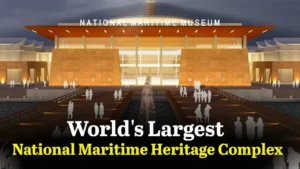
About National Maritime Heritage Complex (NMHC) –
- It is a flagship project of the Govt of India to piece together the entire 5000 years of India’s maritime history and showcase it under one roof.
• The Ministry of Ports, Shipping, and Waterways, under its SagarMala Programme, is
developing the NMHC at Lothal, Gujarat.
- The location–‘Lothal’–is significant since it is one of the prominent cities of the ancient Indus Valley Civilisation (IVC) dating back to 2400 BC, located 76 km from Ahmedabad in
- It is the only port town of the
- Archaeological excavations have discovered the oldest man-made dockyard, over 5000 years old, in Lothal.
- The NMHC is envisioned to be one of the largest maritime complexes in the
- It will be a one of its kind, digitally enhanced, experiential museum with the aim of attracting tourists and historians from all over the world, who will get to see and learn about the rich and diverse maritime history of India.
• The Ministry of Ports, Shipping, and Waterways has appointed the Indian Ports Association as the nodal agency, while Indian Port Rail Corporation Ltd. (IPRCL) is the executing agency of the project.
- It is being developed in an area of about 400 acres with an estimated cost of 4500 crore.
• Funding —
• The NMHC project shall be funded by the Ministry of Shipping and Ministry of Culture through National Culture Fund by way of grant.
- In the future, other Central Line Ministries, Coastal States & UTs, other government institutions, private organisations, and the public shall be approached for contributions either from their CSR funds or otherwise to the bank account of IPRCL-NMHC vertical.
- NMHC is planned to be developed in various
- Phase 1A will have an NMHC museum with six galleries, which also includes an Indian Navy & Coast Guard gallery envisaged to be one of the largest in the
- Phase 1B will have NMHC museum with 8 more galleries, Lighthouse museum which is planned to be the world’s tallest, and the Bagicha complex (with a car parking facility for about 1500 cars, a food hall, a medical centre, ).
- Phase 2 will have coastal states’ pavilions, a hospitality zone, a recreation of real-time Lothal City, Maritime Institute and hostel and four theme-based parks.
- Phases 1A and 1B of the project are to be developed in EPC mode, and Phase 2 of the project will be developed through land subleasing/PPP to establish NMHC as a world- class heritage museum.
• A separate society will be set up for the development of future phases, to be governed by a Governing Council headed by the Minister of Ports, Shipping, and Waterways.
- This society will manage the implementation and operation of the
Reinforcement Learning (RL)
In a paper published recently, the DeepSeek-AI team reported that their model, called just R1, could develop new forms of reasoning using reinforcement learning, a method of trial and error guided only by rewards for correct answers.
About Reinforcement Learning (RL) –
• It is defined as a sub-field of machine learning (ML) that enables AI-based systems to take actions in a dynamic environment through trial and error methods to maximise the collective rewards based on the feedback generated for respective actions.
- In RL, an autonomous agent learns to perform a task by trial and error in the absence of any
guidance from a human user.
- RL algorithms use a reward-and-punishment paradigm as they process
- RL is based on the hypothesis that all goals can be described by the maximisation of expected cumulative reward.
- The RL agent learns about a problem by interacting with its environment. The environment provides information on its current state.
- The agent then uses that information to determine which actions(s) to
- If that action obtains a reward signal from the surrounding environment, the agent is encouraged to take that action again when in a similar future state.
• This process repeats for every new state
- Over time, the agent learns from rewards and punishments to take actions within the environment that meet a specified goal.
- The learning process in RL is driven by a feedback loop that consists of four key elements —
- Agent:The learner and decision-maker in the
- Environment:The external world the agent interacts
- Actions: The choices the agent can make at each
- Rewards: The feedback the agent receives after taking an action, indicating the desirability of the outcome.
• It particularly addresses sequential decision-making problems in uncertain environments
and shows promise in artificial intelligence development.
Strategic Lawsuits Against Public Participation (SLAPP)
Over a year before a civil court imposed an ex-parte injunction on journalists from publishing or circulating allegedly unverified and defamatory material against Adani Enterprises, the Supreme Court had been worried about courts recognising ‘SLAPP’ suits across jurisdictions.
About Strategic Lawsuits Against Public Participation (SLAPPs) –
• SLAPPs are meritless suits solely used to drag the opposing party through protracted litigation to dry up their resources.
- These lawsuits are typically filed by influential and wealthy individuals or businesses against people who criticise them, conduct investigations, communicate, or express opinions on matters of public interest.
- SLAPPs often target journalists and the media, as well as NGOs, academics, researchers, writers, artists, and human rights defenders-in general people who engage in public discourse and demand accountability.
• SLAPPs shut down critical speech by intimidating critics and draining their resources, undermining their active public engagement.
- Moreover, one core characteristic of this kind of action is the disparity of power and resources between the plaintiff and the defendant.
- Often based upon ambiguous and elastic law provisions, SLAPPs use several strategies to exhaust resources and morale, generally including exorbitant claims for damages and allegations designed to smear, harass and overwhelm activists and/or civil society
- Many nations (the USA, Canada, UK, and others) have enacted anti-SLAPP laws granting early dismissal of frivolous suits and fee-shifting to protect public
- India has no such statute, so courts must rely on existing civil procedure rules and constitutional guarantees.
- The Supreme Court of India warns against ‘SLAPP’ suits, emphasises the protection of journalistic expression in defamation cases.
Petroleum and Natural Gas Regulatory Board (PNGRB)
The Petroleum and Natural Gas Regulatory Board (PNGRB) recently invited stakeholder and consumer comments on an LPG interoperability framework that would allow households to draw refills from distributors of other PSU oil companies, similar to mobile number portability.

About Petroleum and Natural Gas Regulatory Board (PNGRB) –
- It is a statutory body established under the Petroleum and Natural Gas Regulatory Board Act 2006.
- Objective: To protect the interests of consumers and entities engaged in specified activities relating to petroleum, petroleum products, and natural gas and to promote competitive markets and for matters connected therewith or incidental
- It has also been mandated to regulate the refining, processing, storage, transportation, distribution, marketing, and sale of petroleum, petroleum products, and natural gas, excluding the production of crude oil and natural gas, so as to ensure an uninterrupted and adequate supply of petroleum, petroleum products, and natural gas in all parts of the
- PNGRB authorises the CGD networks, natural gas and petroleum product pipelines, determines tariffs, lays down the technical and safety standards,
• Nodal Ministry — Ministry of Petroleum and Natural Gas.
- The Board has its seat in
- The Board consists of 1 Chairperson, 3 members, and 1 Member (Legal).
• Powers —
- The Board shall have jurisdiction to
- Adjudicate upon and decide any dispute or matter arising amongst entities or between an entity and any other person on issues relating to refining, processing, storage, transportation, distribution, marketing, and sale of petroleum, petroleum products, and natural gas, unless the parties have agreed for arbitration;
• Receive any complaint from any person and conduct any inquiry and investigation connected with the activities relating to petroleum, petroleum products, and natural gas on contravention of —
• Retail service obligations;
• Marketing service obligations;
- Display of retail price at retail outlets;
- Terms and conditions subject to which a pipeline has been declared as a common carrier or contract carrier or access for other entities was allowed to a city or local natural gas distribution network, or authorisation has been granted to an entity for laying, building, expanding, or operating a pipeline as a common carrier or contract carrier, or authorisation has been granted to an entity for laying, building, expanding or operating a city or local natural gas distribution network;
- Any other provision of this Act or the rules or the regulations or orders made
- While deciding on a complaint, the Board may pass such orders and issue such
directions as it deems fit or refer the matter for investigation.
- Decisions of the Board are binding on parties of The Board’s orders are
enforceable, as the powers vested are the same as in a civil court.
- The Board has powers to review its own decisions by way of a Review The
decision can be challenged by way of an appeal in the Appellate Tribunal.
Moran community
The Moran community in Assam has ramped up the pressure in their demand for Scheduled Tribe status.
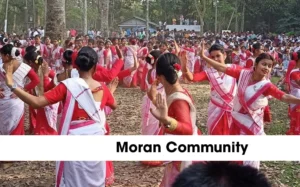
About Moran community –
- The Moran is a lesser known indigenous community mainly concentrated in the Tinsukia district of Assam and also residing in Arunachal Pradesh.
- It is said that prior to the advent of the Ahoms, the Morans had their own independent kingdom at Bengmara, which is the present day Tinsukia.
- Language: They had a common dialect of their own which was derived from the Bodo group of
Tibeto-Burman linguistic family. Later they started using Assamese.
• Religious Affiliation of Morans —
- Morans are Vaishnava by religion and belong to the Moamoria
- They were introduced to Vaishnavism by Sri Aniruddha Deva, disciple of Sri Sankara
- Prior to their conversion to Vaishnavism were the followers of Shakta faith affiliated to the
Kechaikhati Than, a shrine where the mother goddess is worshipped.
- Festivals: They celebrate Gasar Talar Bihu (Bihu dance performed under a tree) is very popular among the Moran tribe and Kheri is also celebrated.
Periyar Tiger Reserve
A recent report from the State Finance Inspection wing, operating under the Finance department, has exposed significant financial irregularities at the Periyar Tiger Reserve.

About Periyar Tiger Reserve –
- Location: It is named after the Periyar River, is located in the Idukki district of
- It is set high at Cardamom Hills and Pandalam Hills of the Western Ghats, adjacent to the border with Tamil Nadu.
- It surrounds the Periyar Lake, which was created in 1895 by building a dam across the Periyar
- Terrain: The terrain is hilly and undulating with a maximum altitude of 2016 The highest peak is Kottamala (2016 m).
- Rivers: Two major rivers namely Periyar and Pamba drain the
- Dams: Mullaperiyar Dam is located within the
- Tribes: It is home to many tribal communities, including the Mannans and the
- Vegetation: It comprises tropical evergreen forests, semi- evergreen forests, moist deciduous forests, transitional fringe evergreen forests, grasslands, and eucalyptus plantations.
- Flora: Important flora includes teak, mangoes, rosewood, jamun, jacarandas, terminalias, tamarind, royal ponciana, bamboo, etc.
- Fauna: Elephants, Wild Pigs, Sambar, Gaur, Mouse Deer, Dole or Barking Deer, Indian Wild Dog, and Tiger.
- The major four species of primates are also found at Periyar – the rare lion-tailed macaque, the Nilgiri Langur, Gee’s Golden Langur, Common Langur, and Bonnet
- It is also being considered as the habitat of the Nilgiri
Daily Current Affairs 20th September 2025 MCQs
1. Consider the following statements about the Bonnard Principle –
- It originated from a judicial ruling in Bonnard vs Perryman (1891).
- It relates to restrictions on granting injunctions in cases of alleged
- Under this principle, a court may grant an injunction merely on suspicion of
Which of the statements given above is/are correct?
- 1 and 2 only
- 2 and 3 only
- 1 and 3 only
- All of the above
Answer – A
Explanation – The Bonnard Principle (1891) holds that an injunction in defamation cases can be granted only if the defendant clearly cannot justify the statement. Mere suspicion of defamation is not sufficient.
2. With reference to fentanyl, consider the following statements –
- Fentanyl is made entirely in laboratories and contains no natural
- Fentanyl is approximately 50 times more potent than
- Only a few grains of fentanyl can be lethal, which contributes to high rates of overdose
Which of the statements given above is/are correct?
- 1 and 2 only
- 1 and 3 only
- 2 and 3 only
- All of the above
Answer – B
Explanation – It is a potent synthetic opioid like morphine or heroin. It is both a prescribed drug and a drug that is at times made and used illegally. It is made entirely in laboratories, with no natural ingredients. It was developed as a prescription medicine for treating severe pain, such as pain after surgery. When used as prescribed, it is also very effective in treating cancer pain or other types of severe chronic pain that don’t respond to other pain medicines. It is also used with other medicines just before or during an operation to help the anesthetic (numbing medicine) work better. It is approximately 100 times more potent than morphine and 50 times more potent than heroin as an analgesic. It acts in the central nervous system (CNS) or brain to relieve pain. Some of its side effects are also caused by actions in the CNS, such as drowsiness or dizziness. Fentanyl is addictive. Like other opioids, repeated use causes changes in brain activity that cause people to continue using it even when they experience harmful effects. Fentanyl is cheap for drug
dealers to make into a street drug, compared to other opioids, but it is more powerful. Because only a few grains is enough to kill, fentanyl is causing high rates of overdose and overdose deaths.
3. Consider the following statements regarding the Harappan Civilisation —
- The Harappan Civilisation was predominantly urban and known for its advanced town planning, including the use of a grid pattern for
- The people of the Harappan Civilisation primarily used bronze tools and weapons, indicating a Bronze Age culture.
- Harappan script, which remains undeciphered, was primarily written from left to
- Lothal was one of the major ports of the Harappan Civilisation, known for its
Which of the statements given above are correct?
- 1 and 2 only
- 1, 2 and 4 only
- 1, 3 and 4 only
- All of the above
Answer – B
Explanation – The Harappan Civilisation, also known as the Indus Valley Civilisation, was renowned for its advanced urban planning. Cities like Mohenjo-Daro and Harappa had a well- planned grid layout for streets, sophisticated drainage systems, and standardised fired bricks for construction. The Harappan Civilisation existed during the Bronze Age and made extensive use of bronze for tools, weapons, and other artifacts. This indicates their advanced metallurgical skills.
The Harappan script remains undeciphered to this day, and while there are various hypotheses about its direction of writing (including right to left, left to right, and boustrophedon), there is no definitive evidence that it was primarily written from left to right. Lothal was a prominent port city of the Harappan Civilisation and is well-known for its dockyard, which is considered one of the earliest known docks in the world. It facilitated maritime trade and commerce.
4. Consider the following statements regarding the Harappan Civilisation —
- The Harappan Civilisation was predominantly urban and known for its advanced town planning, including the use of a grid pattern for
- The people of the Harappan Civilisation primarily used bronze tools and weapons, indicating a Bronze Age culture.
- Harappan script, which remains undeciphered, was primarily written from left to
- Lothal was one of the major ports of the Harappan Civilisation, known for its
Which of the statements given above are correct?
- 1 and 2 only
- 1, 2 and 4 only
- 1, 3 and 4 only
- All of the above
Answer – B
Explanation – The Harappan Civilisation, also known as the Indus Valley Civilisation, was renowned for its advanced urban planning. Cities like Mohenjo-Daro and Harappa had a well- planned grid layout for streets, sophisticated drainage systems, and standardised fired bricks for construction. The Harappan Civilisation existed during the Bronze Age and made extensive use of bronze for tools, weapons, and other artifacts. This indicates their advanced metallurgical skills.
The Harappan script remains undeciphered to this day, and while there are various hypotheses about its direction of writing (including right to left, left to right, and boustrophedon), there is no definitive evidence that it was primarily written from left to right. Lothal was a prominent port city of the Harappan Civilisation and is well-known for its dockyard, which is considered one of the earliest known docks in the world. It facilitated maritime trade and commerce.
5. Consider the following statements regarding Strategic Lawsuits Against Public Participation (SLAPPs) –
- SLAPPs are usually filed by wealthy individuals or corporations to silence critics through prolonged litigation.
- They often target journalists, researchers, NGOs, and other individuals engaged in matters of public interest.
- India has enacted an anti-SLAPP statute similar to those in the USA and
- The Supreme Court of India has cautioned against the misuse of SLAPP suits in defamation
Which of the statements given above are correct?
- 1 and 2 only
- 1, 2 and 4 only
- 3 and 4 only
- All of the above
Answer – B
Explanation – SLAPPs are meritless suits solely used to drag the opposing party through protracted litigation to dry up their resources. These lawsuits are typically filed by influential and wealthy individuals or businesses against people who criticise them, conduct investigations, communicate, or express opinions on matters of public interest. SLAPPs often target journalists and the media, as well as NGOs, academics, researchers, writers, artists, and human rights defenders-in general people who engage in public discourse and demand accountability. SLAPPs shut down critical speech by intimidating critics and draining their resources, undermining their active public engagement. Moreover, one core characteristic of this kind of action is the disparity of power and resources between the plaintiff and the defendant. Often based upon ambiguous and elastic law provisions, SLAPPs use several strategies to exhaust resources and morale, generally including exorbitant claims for damages and allegations designed to smear, harass and overwhelm activists and/or civil society organisations. Many nations (the USA, Canada, UK, and others) have enacted anti-SLAPP laws granting early dismissal of frivolous suits and fee-shifting to protect public participation. India has no such statute, so courts must rely on existing civil procedure rules and constitutional guarantees. The Supreme Court of India warns against ‘SLAPP’ suits, emphasises the protection of journalistic expression in defamation cases.
Source – The Indian Express
Also read Daily Current Affairs – 22 September 2025 | Top News





